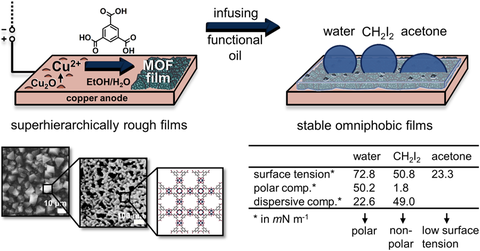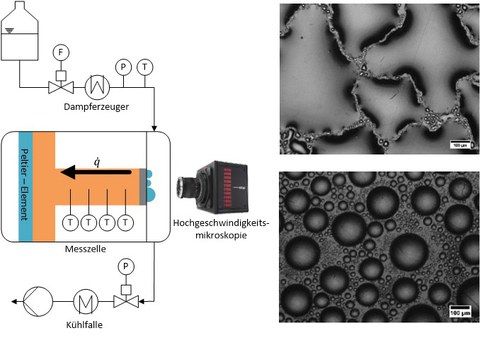Tropfenkondensation
Tropfenkondensation von Kälte- und Lösemitteln auf funktionalisierten Oberflächen für hocheffiziente Wärmeübertrager
|
Bearbeiter: |
|
|
Laufzeit: |
10/2018 bis 09/2021 |
|
Förderinstitution: |
Europäischer Fond für regionale Entwicklung (EFRE) |
Projektziele
- Entwicklung einer Oberflächenmodifikation mit omniphoben Eigenschaften
- Verfahrensentwicklung zur elektrochemischen Synthese omniphober Beschichtungen
- Nachweis des verbesserten Wärmeübergangs bei der Kondensation auf den omniphoben Oberflächen
- Ableiten eines allgemeinen Modells zur Berechnung des Wärmeübergangs
Abb. 1: Herstellung omniphoberOberflächen. Elektrochemisch abgeschiedene Schichten aus metallorganischen Gerüst-verbindungen (MOF) ermöglichen eine stabile Imprägnierung mit einem funktionellem Öl. Es entsteht eine omniphobeOberfläche, die abweisend gegenüber einer Vielzahl von Flüssigkeiten ist.
Abbildung aus:
J. Sablowski et al., „Electrodeposited metal-organic framework films as self-assembled hierarchically superstructured supports for stable omniphobic surface coatings“, Scientific Reports, Bd. 8, Nr. 1, S. 15400, 2018.
Einordnung des Vorhabens
Die Kondensation von Fluiden mit geringer Oberflächenspannung spielt im Bereich der Kälte- und Wärmebereitstellung aber auch bei der Verarbeitung und Rückgewinnung von Lösemitteln eine herausragende Rolle. Im Sinne der Energie- und Ressourceneffizienz besteht das Ziel, den Wärmeübergangskoeffizienten mittels Tropfenkondensation speziell bei diesen Fluiden zu erhöhen. Die Wärmeübergangskoeffizienten werden an einer Versuchsanlage der Professur EVT experimentell ermittelt.
Abb. 2: Schema der Versuchsanlage zum Messen der Wärmeübergangskoeffizienten (links), Aufnahmen des Kondensationsprozesses im Übergangsbereich (rechts oben) und bei Tropfenkondensation (rechts unten)



